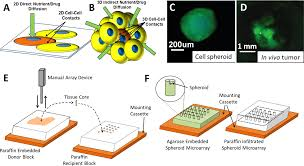
Spheroids embedded in collagen for cancer research
Collagen is the most prevalent embedding material as it has both the components of the extra cellular matrix and is upregulated within a tumor microenvironment. It is further preferred due to its mechanical strength, pore size and fibril fraction by varying the concentration and preparation methods. Spheroids are prepared utilising one of the earlier used methods such as hanging drop method or liquid overlay and are transferred into a collagen gel (1).
Overcoming difficulties in collagen embedding
While embedding increases the utility of the model, it is time intensive, creating a bottle neck for high throughout spheroid formation. One strategy to overcome this is to automate the process by microinjecting a mixture of cells and the polymer polyvinylpyrrolidone in collagen gels. The polymer immobilizes the cells at the site of injection and thus reduces times for spheroid formation. The spheroids are comparable to those formed from hanging drop method (2).
This system is suitable for variable cell types and includes cells that usually require additives like Matrigel to attain spheroid formation. An alternate strategy consists of labelling cells with magnetic liposomes and directing their growth in a 3D collagen gel with magnetized iron pin holder array (3).
While these approaches successfully adapt embedding to a high throughput assay, they are limited by their reliance on imaging as the basis of subsequent analysis. However, these methods along with future high throughput approaches will facilitate the study of cancer biology, drug responses and differentiation (4).
References
1. Harjanto D, Maffei JS, Zaman MH. PLoS One. 2011;6: e24891
2. Truong HH, de Sonneville J, Ghotra VPS, Xiong J, Price L, Hogendoorn PCW, Spaink HH, van de Water B, Danen EHJ. Biomaterials. 2012; 33:181
3. Okochi M, Takano S, Isaji Y, Senga T, Hamaguchi M, Honda H. Lab Chip. 2009; 9:3378.
4. Kristie M. Tevis,1 Yolonda L. Colson,2, * and Mark W. Grinstaff1,*Embedded Spheroids as Models of the Cancer Microenvironment, PubMed central.



